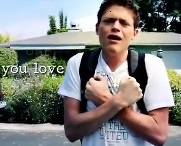Accessibility: Potentials and Limitations
This section dissects the limitations and potential of ASL music videos and accessible multimodal compositions that are not fully accessible by all bodies. We can critique and learn from any composition to develop strategies for redesigning multimodal texts and reach more senses. I turn to Sushil Oswal (2013) to emphasize that ASL music videos are not perfectly accessible compositions and to clarify that I’m not claiming that Deaf composers are better or greater than non-deaf composers. It would be problematic for us to presume that we can be illuminated by those who cannot hear (or see, or so forth). Instead, we need to recognize that we can always engage in the process of designing different ways to communicate equally across modes and access more bodies.
I recognize that ASL music videos are not fully accessible compositions. But I argue that they are a major teaching opportunity for scholars and students since they show how multimodal compositions can be recreated in order to include audience members who have been traditionally excluded from accessing the compositions.
We should ask our students and ourselves: If designers can create music videos that allow deaf individuals to visually access sound, then what other compositions can we design? In what ways can we embody visual modes for those who cannot see—beyond alternative text descriptions of images? In what ways can we reach out to those who cannot see and cannot hear? How can we allow more individuals to access the image on this page of a man and woman dancing the M-m-m-mambo!?

Figure 6: Screenshot from Sean Forbes’ (2011) video, “Sean Forbes ‘Let’s Mambo’ Ft. Marlee Matlin”
Why should we critique works that seem accessible, such as ASL music videos? Because in order to recognize the potential for improving the ways we express meaning, we need to recognize the limitations of any mode and combination of modes. We need to consider the limitations of ASL music videos and of any multimodal composition that may be more or less accessible than others.
Sushil Oswal (2013) defined accessibility “as the ability to use, enjoy, perform, work on, avail of, and participate in a resource, technology, activity, opportunity, or product at an equal or comparable level with others” (Technologies section, para. 13). He added, “accessibility at the interface level, not as a retrofit or add-on, is true accessibility” (Technologies section, para. 13). I propose that we should embody Oswal’s definition of accessibility when we design our own accessible multimodal pedagogy. We need to embody his definition of accessibility as a design consideration and as the ability to participate; we need to encourage our students to design for a range of audiences when they create compositions that use multiple modes.
I believe that analyzing ASL music videos can guide students through exploring the affordances of modes and the limitations of technologies in creating accessible multimodal compositions. When we study a multimodal composition, we can find ways that each mode is inhospitable, or not accessible, to a certain group of users or individuals.
Oswal challenged how able-bodied individuals hold “ableist” assumptions (or assume by default that everyone is the same and is able to perform the same actions) that affect the way they communicate or design compositions (Technologies section, para. 10). For instance, he would argue that ASL music videos are inhospitable to blind individuals because they seem to reflect the ableist assumption that everyone can see the visual text.
I do not have a perfect solution for making ASL music videos fully accessible—but I might suggest a form of descriptive audio such as those provided for films and television shows in which the visual actions of the signs, bodies, and dynamic visual text are described in audio form. I welcome critiques and suggestions for redesigns.
It is this continual action of critiquing and redesigning every composition that forms the heart of an accessible multimodal pedagogy. We need to analyze ASL music videos and other compositions that embody meaning across different modes in order to recognize different ways to design compositions that use multiple modes to reach a range of audiences. Our students need to see the limitations (“Wait, ASL music videos exclude those who cannot see”) in order to find the potentials (“Oh, our class could design a video with descriptive audio this semester in order to include those who cannot see”). Analyzing the limitations and potential of each mode in making meaning accessible is a crucial step towards recognizing the design choices that are available to us as composers.
